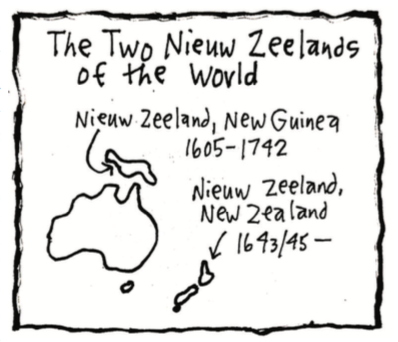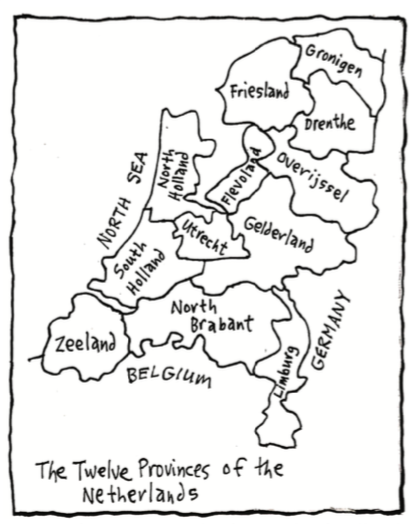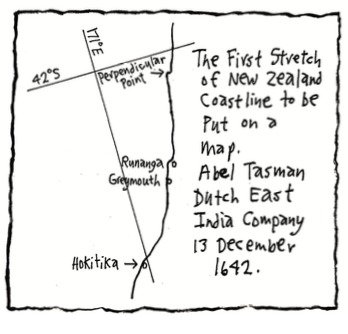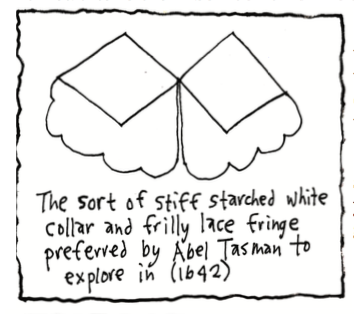THE DUTCH IN NEW ZEALAND
The first people to come to New Zealand after the Maori, and the first people to put the location of New Zealand on a map, record its existence in writing, and give it its name; are the Dutch. Yet the Dutch never stepped foot on New Zealand, and nobody really knows to this day how New Zealand got its name. It’s a complicated story. But then it’s New Zealand history.
Between the years 1605-1799, there are actually two New Zealand’s in this world, thanks to the Dutch. In November 1605 the Dutch East India Company explorer Willem Jans (or Janz or Janszoon, the suffix “zoon” or “son”is found in many of the surnames of the early Dutch explorers but is no longer in use), sails from Banda Island, Indonesia to east of Ceram Island, and then east between the Kai and Aru Islands and the southwest coast of New Guinea; and names a stretch of this New Guinea coastline “Nieu Zelandt”.

Jans then goes on to sail into the Gulf of Carpentaria, Australia, thus becoming the first person to put the location of Australia on a map (the west coast of the Cape York Peninsula), record it’s existence (26 February 1606), and give it its first placenames (Duifken Point, Cape Keerweer).
Willem Jans was the first person to record the discovery of Australia, but unfortunately, he’s not overly remembered for it. The Aussies hardly give him a mention and February 26 is just another day in Australia. (James Cook is not even born for another 122 years after 1606, and does not appear in Australia for another 42 years after that.)
Numerous Dutch maps between the years 1622-1792 show “Nieu Zelandt” in various locations in the vicinity of the southwest coast of New Guinea. But after 1792 the name gradually disappears.
There is however another New Zealand too. This second New Zealand is the New Zealand we know today as New Zealand, the New Zealand whose location and existence were first recorded on a map in 1642 by Abel Tasman, another Dutch East India Company explorer.
But Abel Tasman didn’t originally call his New Zealand, New Zealand; he called it “Staten Landt” (States Land), because he thought it might be connected to lands also discovered by the Dutch at the southeast tip of South America in 1615 and already named “Staten Landt”.
Tasman’s “Staten Landt” name didn’t stick however because, also in 1642, Hendrik Brouwer, another Dutch explorer, proved that the South American “Staten Landt” was just an island and therefore couldn’t be connected in any way to Tasman’s “Staten Landt”. This island is now called “Isla de los Estados” (Island of the States) and is in Tierra del Fuego, Argentina.
So The Dutch East India Company had to come up with another name for Abel Tasman’s “Staten Landt”, and sometime between 1643 and a map appearing in 1645, they named it “Nieu Zeeland” (or “Zelandia Nova” in Latin). Nobody really knows why.

Zeeland is the most southwesterly of the 12 Dutch provinces, and one of the smallest in population and land area, with no well known city or football club. It does though border on the sea and have the most water area (Zeeland means “Sealand”). New Zealand is 92 times bigger than Old Zeeland.
The current accepted explanation for the name “Nieu Zeeland” is that it was decided upon for some reason by the directors of The Dutch East India Company, perhaps to honour an important investor or somebody connected to the Company who came from Zeeland province. We’ll probably never know for sure. Anyway, it got the name.
What we do know though is why it wasn’t named New Zealand. It wasn’t named New Zealand in honour of Abel Tasman. Tasman came from Lutjegast in the province of Gronigen in the far north of Holland, not Zeeland.
Abel Tasman’s two ships were named the “Zeehaen” and the “Heemskerck”. Zeehaen means chicken or sea-hen, and Heemskerck is a town in the Dutch province of North Holland; so New Zealand wasn’t named after either Abel Tasman or his ships.
Abel Tasman was sent exploring by Anthonie Van Diemen, the Governor-General of The Dutch East India Company at the time. Van Diemen came from Culemborg in the Dutch province of Gelderland. So New Zealand wasn’t named in honour of Anthonie Van Diemen either.
But Nieu Zeeland it was, and New Zealand it is today. Drop an “i” and a “u” and add a “w”, and change an “e” to an “a” and you’ve got it. A Dutch name converted to an English one. An English-speaking Polynesian country with a Dutch name.

Abel Tasman was a sea captain for The Dutch East India Company of Jakarta, Indonesia. In 1642, Anthonie Van Diemen, the Governor-General of The Dutch East India Company, sends Tasman and two ships out on an expedition to discover what the connection was between the south coast of New Guinea and these pieces of coastline called New Holland (Australia) that the Dutch had been bumping into ever since Willem Jans sailed into The Gulf of Carpentaria and discovered Australia in 1606.
But instead of sailing east from Jakarta to New Guinea as instructed, for some reason Tasman sails west to Mauritius, and from there finds himself sailing not along the south coast of New Guinea, but along the south coast of some other unknown land (Tasmania, Australia).

- Chapter One Part one: A Humorous History of NZ
- Chapter One Part two: A Humorous History of NZ
- Chapter Two Part one: NZ is Formed
- Chapter Two Part two: NZ is Formed
- Chapter Three Part One: People Come to NZ
- Chapter Three Part Two: People Come to NZ
- Chapter Four Part One: The Maori of New Zealand
- Chapter Four Part Two: The Maori of New Zealand









